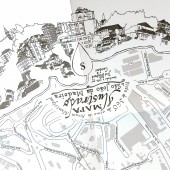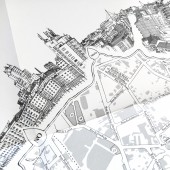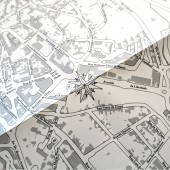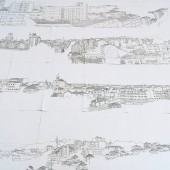
| THE AWARD |
| CATEGORIES |
| REGISTRATION |
| SUBMIT YOUR WORK |
| ENTRY INSTRUCTIONS |
| TERMS & CONDITIONS |
| PUBLICATIONS |
| DATES & FEES |
| METHODOLOGY |
| CONTACT |
| WINNERS |
| PRESS ROOM |
| GET INVOLVED |
| DESIGN PRIZE |
| DESIGN STORE |
| THE AWARD | JURY | CATEGORIES | REGISTRATION | PRESS | WINNERS | PUBLICATIONS | ENTRY INSTRUCTIONS |
Bird's-Eye View of São João Da Madeira City Map by José Miguel Cardoso |
Home > Winners > Design #60850 >Interview |
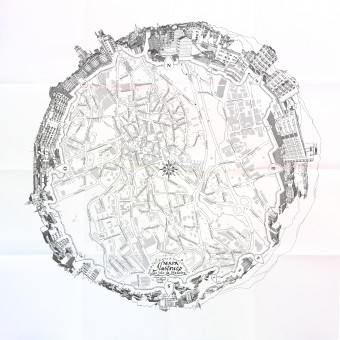 |
|
FS: What is the main principle, idea and inspiration behind your design?
JC: This map is inspired in the tradition of creating Portulano charts in the Portuguese discoveries that place the observer of the landscape as the central figure of the representation. I was also influenced by and the urge to represent the world through observation, from the golden era of Dutch painting, which relates to bird's eye views.
FS: What has been your main focus in designing this work? Especially what did you want to achieve?
JC: The main focus was to create a hybridism between the code of cartographic representation and the observational drawing of of the landscape. An observation of who is in that place for a long time. In this way it is possible to highlight the spirit of the place.
FS: What are your future plans for this award winning design?
JC: But this prize also serves to validate the approach, which I will apply in other future projects.
FS: How long did it take you to design this particular concept?
JC: Two months. One month for all the observational drawings, and another month to finish de design production part.
FS: Why did you design this particular concept? Was this design commissioned or did you decide to pursuit an inspiration?
JC: This project was commissioned by the parish council of the city of São João da Madeira. They wanted an illustrated map that served as a business card for the city.
FS: Is your design being produced or used by another company, or do you plan to sell or lease the production rights or do you intent to produce your work yourself?
JC: This first edition is being sold by the parish council that commissioned the work. In the future i plan to do other author editions.
FS: What made you design this particular type of work?
JC: There is an annual event in this city called International Encounters of Illustration, which give a special relevance to this work.
FS: Where there any other designs and/or designers that helped the influence the design of your work?
JC: This work stems from an evolution and research on the design of landscape representation, which I have been doing for some years. In this sense it is an individual work.
FS: Who is the target customer for his design?
JC: This map is intended for the general population of the city, because it shows a landscape with which everyone identifies themselves, its not a functional map. However, it has also a symbolic function of affirmation of this small city in the Portuguese cultural panorama.
FS: What sets this design apart from other similar or resembling concepts?
JC: What differentiates this map is the authorship nature that it acquires with the inclusion of the observational landscape drawing, done by hand. The drawing of observation is always subject to a temporal experience, thus becoming unique and unrepeatable.
FS: How did you come up with the name for this design? What does it mean?
JC: The name for this map was already decided at the time of the order, because it was intended to be presented at the opening of the International Illustration Meetings.
FS: Which design tools did you use when you were working on this project?
JC: Bic pen, A3 paper sheets, Adobe Illustrator and Adobe Indesign.
FS: What is the most unique aspect of your design?
JC: The unique aspect of this design is certainly the landscape drawing with a 360º view of the city.
FS: Who did you collaborate with for this design? Did you work with people with technical / specialized skills?
JC: I had some support from the parish council of the city, to indicate the contents and points of interest to raise on the map. In the design and production part of the map, I worked alone.
FS: What is the role of technology in this particular design?
JC: This work is not based essentially on technology, but rather on the experiential side of the designer and his relation to the place.
FS: Is your design influenced by data or analytical research in any way? What kind of research did you conduct for making this design?
JC: I am a PhD Candidate on Design, and i argue that the more massified systems of landscape and landscape represent all places in the same way. What in my perspective is a factor of impoverishment. I understand that it should be the place to dictate your own representation. A Genius Loci mapping. Maps tailored to the body of places.
FS: What are some of the challenges you faced during the design/realization of your concept?
JC: The most difficult part of this challenge was getting access to a place in the city where you could have access to a 360-degree panoramic view and could also spend many days drawing. It was not a matter of drawing, but where to draw. Fortunately, I was able to count on the Mayor's authorization to meet me in this part of the building.
FS: How did you decide to submit your design to an international design competition?
JC: After the project was completed, I began to think that it might have the quality to be awarded. On the other hand, these kinds of awards are important at this stage of the career because they help validate my research on landscape representation.
FS: What did you learn or how did you improve yourself during the designing of this work?
JC: I improved a lot, especially about landscape drawing. These long drawings help us build a proper repertoire of forms, which we can later call upon for new projects.
FS: Any other things you would like to cover that have not been covered in these questions?
JC: That is all.
FS: Thank you for providing us with this opportunity to interview you.
A' Design Award and Competitions grants rights to press members and bloggers to use parts of this interview. This interview is provided as it is; DesignPRWire and A' Design Award and Competitions cannot be held responsible for the answers given by participating designers.
| SOCIAL |
| + Add to Likes / Favorites | Send to My Email | Comment | View Press-Release |

